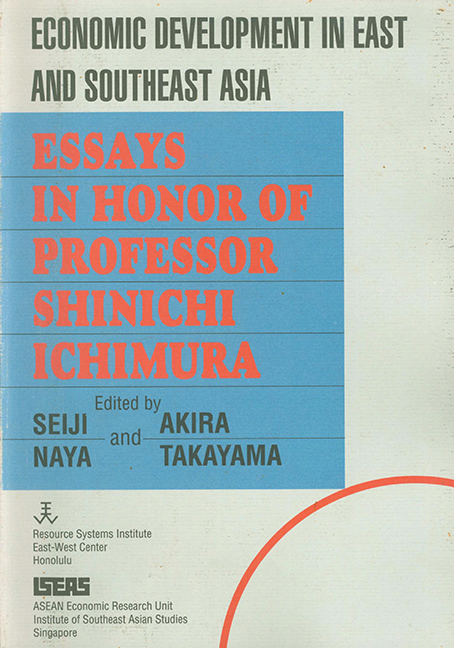Book contents
- Frontmatter
- Preface
- Shinichi Ichimura, 1925-
- CONTENTS
- Introduction
- Contributors to This Volume
- I Structural Change and Economic Development in Developing Asia in the 1990s
- II Explaining the Success of the Four Little Dragons: A Survey
- III Taiwan's Economic Miracle: A Singaporean Perspective
- IV Singapore's Experience of Industrial Restructuring: Lessons for the Other Asian NIEs
- V Korean Industrial Policies for Declining Industries
- VI Vietnam: Recent Economic Developments and the World Economy
- VII Transition from Import Substitution to Export Expansion: The Thai Experience
- VIII Adjustment Problems of a Small Oil-Exporting Country: Did Indonesia Suffer from the Dutch Disease?
- IX A Quarterly Econometric Model of the Hong Kong Economy
- X The Effect ofRicardian Rent Extracting on Macroeconomic Performance
- XI Direct Foreign Investment and the Economic Development of Korea
- XII Japanese Investment in Thailand: Looking Back and Into the Future
- XIII The Effects of Direct Foreign Investment on Taiwan: A Macroeconometric Investigation
- XIV A Reform of the Foward Foreign Exchange Market and Foreign Exchange Rate Determination Policy in Korea, with Foreign Exchange Policy Experiences of Taiwan
- XV Interest Rate and Foreign Exchange Liberalization in Taiwan in the 1980
- XVI Manifold Dilemmas behind External Debt Management
- XVII Agricultural Growth and Food Imports in Developing Countries: A Reexamination
- XVIII The Transformation of Rural Asia and Economic Development Theory and Policy
- XIX The ASEAN Summit and ASEAN Economic Cooperation
- XX The Role of Developing Countries in the New GATT Round
- XXI The Emerging Global Economy and the Role of the Asian NIEs
- Index
XVIII - The Transformation of Rural Asia and Economic Development Theory and Policy
Published online by Cambridge University Press: 21 October 2015
- Frontmatter
- Preface
- Shinichi Ichimura, 1925-
- CONTENTS
- Introduction
- Contributors to This Volume
- I Structural Change and Economic Development in Developing Asia in the 1990s
- II Explaining the Success of the Four Little Dragons: A Survey
- III Taiwan's Economic Miracle: A Singaporean Perspective
- IV Singapore's Experience of Industrial Restructuring: Lessons for the Other Asian NIEs
- V Korean Industrial Policies for Declining Industries
- VI Vietnam: Recent Economic Developments and the World Economy
- VII Transition from Import Substitution to Export Expansion: The Thai Experience
- VIII Adjustment Problems of a Small Oil-Exporting Country: Did Indonesia Suffer from the Dutch Disease?
- IX A Quarterly Econometric Model of the Hong Kong Economy
- X The Effect ofRicardian Rent Extracting on Macroeconomic Performance
- XI Direct Foreign Investment and the Economic Development of Korea
- XII Japanese Investment in Thailand: Looking Back and Into the Future
- XIII The Effects of Direct Foreign Investment on Taiwan: A Macroeconometric Investigation
- XIV A Reform of the Foward Foreign Exchange Market and Foreign Exchange Rate Determination Policy in Korea, with Foreign Exchange Policy Experiences of Taiwan
- XV Interest Rate and Foreign Exchange Liberalization in Taiwan in the 1980
- XVI Manifold Dilemmas behind External Debt Management
- XVII Agricultural Growth and Food Imports in Developing Countries: A Reexamination
- XVIII The Transformation of Rural Asia and Economic Development Theory and Policy
- XIX The ASEAN Summit and ASEAN Economic Cooperation
- XX The Role of Developing Countries in the New GATT Round
- XXI The Emerging Global Economy and the Role of the Asian NIEs
- Index
Summary
Agriculture in Economic Development Theory
Economic development theory and planning in the 1950s and early 1960s focussed on industrialization, and to a considerable degree, neglected the role of agriculture in the development process. Like most developing countries, the Asia-Pacific developing economies followed the familiar pattern of adopting import-substitution strategies for industrialization. These strategies involved policies that biased incentives against agriculture and export activities of all types. The two basic premises of inward-looking import-substitution strategies were: first, that farm households in traditional agriculture were unresponsive to market incentives and modern technologies; and second, that prospects for exports, particularly of agricultural commodities, were bleak because of low elasticities of demand and supply and the alleged secular decline in developing countries' terms of trade. These premises turned out to be wrong. But the early export pessimism expounded by Prebisch and others combined with the fallacy of the “uneconomic peasant” provided an intellectual basis for industrial promotion and agricultural neglect (Bhagwati 1984).
Development theory assumed that abundant surplus labor was readily available in the rural economy. Economists developed models with a horizontal supply of labor to the “modern” or industrial sector, based on the idea of surplus labor with marginal product of zero in the traditional (agricultural) sector. The focus of these models was on rapid capital formation in the industrial sector. The propensity of industrial entrepreneurs (be they from the private or the government sector) to save and invest out of profits was assumed to be much higher than of rural farm households. Implicit in these models was a trade-off between growth and equity, and domestic obstacles to rapid industrial development were not well recognized. The protected private monopolists and government bureaucrats were treated as “platonic guardians” rather than as self-interested economic agents (Krueger 1986). Economists meanwhile engaged in sterile debate over whether or not the assumption of labor with zero marginal product in agriculture was warranted. (Actually, one needed only to assume that average product exceeded marginal product.)
Early development models also underestimated the difficulties involved in making a transition from a traditional rural-based economy to a modern industrial one (Bhagwati 1984). In particular, the problems of absorbing fastgrowing, low-skilled labor from rural areas into modern industry were not anticipated very well. The challenges of human resource development have been particularly great in Asian countries, with their large and rapidly growing populations and their limited land and other resources.
- Type
- Chapter
- Information
- Economic Development in East and Southeast AsiaEssays in Honor of Professor Shinichi Ichimura, pp. 281 - 298Publisher: ISEAS–Yusof Ishak InstitutePrint publication year: 1990



